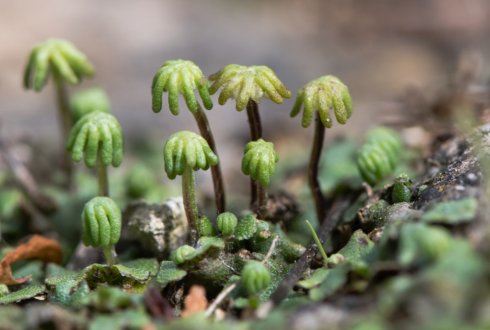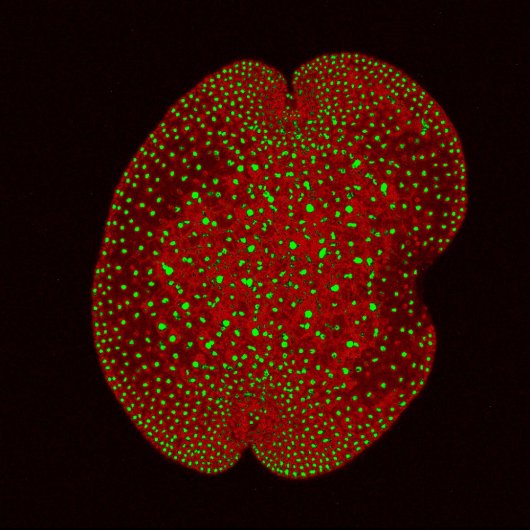Wageningen, The Netherlands
May 18, 2020

Leadphoto: Marchantia polymorpha
In a new study researchers from Wageningen University & Research in the Netherlands and colleagues in Japan and Spain have found a simple mechanism for control of plant growth. Implementation of these findings can help growers to design new crops with for example resistance against disease, drought or flood. They publish their discovery in Nature Plants of 15 May.
The research team shows that the enormously complex response to the plant hormone auxin can be reduced to a very simple switch-like model. Basically, auxin toggles one gene switch from ‘off’ to ‘on’, and at the same time, a second factor competes with this switch and thereby determines how sensitive each cell is to the hormone. Therefore, the numerous ways that plant cells react to auxin, whether it is a root branch or a the formation of a flower, depend on the combination of an on/off switch with a volume control knob.
The small auxin molecule is known to control many aspects of plant growth and development, and does so by changing the activity of many genes. DNA-binding ARF proteins bind to genes and switch these on or off, and auxin determines whether ARF proteins are active or not. Most plants have many different copies of the ARF proteins, derived from duplicating genes during evolution, followed by changes in their properties. What follows is a very complex web of ARF proteins that can trigger unique responses to the same hormone.
The team studied the auxin response system of the liverwort Marchantia polymorpha. This plant is an early land plant and has the simplest possible auxin response system, as the researchers described in an earlier paper in eLife that led to the awarding of the Wageningen Research Award to Hirotaka Kato and Sumanth Mutte in 2019. In the new study in Nature Plants, the team now made use of the extreme simplicity of the Marchantia auxin response system, and dissected its workings through a combination of genetics and protein biochemistry. The work revealed a very simple design of two competing ARF proteins to be at the heart of the auxin system.

ARF1 protein in Marchantia marked with a fluorescent protein (photo: Shubhajit Das)
Fundamental view change for auxin
“We believe that our finding will fundamentally change the way researchers view the workings of the important auxin hormone,” says Dolf Weijers, head of the Laboratory of Biochemistry and leader of the research team. “At the same time, this leap in our understanding of how cells respond to the hormone gives unprecedented new abilities to modify cellular hormone responses in crop plants, where propagation, rooting and many other traits that depend on auxin response.”
Fooled by complexity
For decades, studies in flowering plants, including the model plant Arabidopsis, have led to the idea that plants use a very complex network of response factors to allow different plant cells to respond in different ways to the same hormone. In this way, some cells will grow, others divide, yet others differentiate. It is also thought to allow the same hormone to trigger root formation and flower formation, depending on where in the plant the response to the hormone occurs. Now, the research team describes their discovery of a very simple principle underlying the complex responses to the plant hormone auxin. It is likely that the same simple principle operates in other plant species, that have large families of ARF proteins. The present study thus helps to better understand how plants, including crops, respond to the hormone.
For their ground-breaking study, experimental biologist Hirotaka Kato, formerly at Wageningen University, presently at Kobe University, collaborated with colleagues at the Wageningen Laboratory of Chemistry and Biophysics, with the Alba Synchrotron in Barcelona and at the University of Kyoto. The study was partly financed by an NWO VICI grant awarded to Dolf Weijers in 2015.
Read the publication:
- Design principles of a minimal auxin response system. Hirotaka Kato, Sumanth K. Mutte, Hidemasa Suzuki, Isidro Crespo, Shubhajit Das, Tatyana Radoeva, Mattia Fontana, Yoshihiro Yoshitake, Emi Hainiwa, Willy van den Berg, Simon Lindhoud, Kimitsune Ishizaki, Johannes Hohlbein, Jan Willem Borst, D. Roeland Boer, Ryuichi Nishihama, Takayuki Kohchi and Dolf Weijers, Nature Plants 15 May 2020.
Plantenwetenschappers ontdekken aan/uit knop voor reactie van planten op hormoon
Wetenschappers van Wageningen University & Research en hun Japanse en Spaanse collega’s hebben in planten een ‘aan/uit’ schakelaar en een ‘volumeknop’ gevonden die de groei van planten sturen. De toepassing van deze ontdekking kan telers helpen nieuwe gewassen te ontwerpen die bijvoorbeeld beter bestand zijn tegen ziekten, droogte of overstromingen. Hun bevindingen zijn gepubliceerd Nature Plants.
Het team onderzoekers heeft aangetoond dat de zeer complexe reactie van planten op het plantenhormoon auxine, teruggebracht kan worden tot een eenvoudig schakel-model. Het komt erop neer dat het auxine een schakelaar van ‘uit’ naar ‘aan’ zet. Tegelijkertijd concurreert een tweede factor met deze ‘schakelaar’ en bepaalt zodoende hoe gevoelig elke cel voor het hormoon is. De vele manieren waarop een plant op auxine reageert, van wortel tot bloei, wordt als het ware bepaald door de aan/uitknop en de volumeregelaar.
Het kleine auxinemolecuul staat erom bekend vele aspecten van plantengroei en ontwikkeling te bepalen door het wijzigen van de activiteit van verschillende genen. DNA-bindende ARF-eiwitten binden zich aan genen, en zetten deze aan of uit. Het is de auxine die bepaalt of de ARF-eiwitten wel of niet actief zijn. De meeste planten beschikken over verschillende ARF-eiwitten, welke gevormd zijn doordat tijdens de evolutie meerdere kopieën zijn ontstaan, waarna hun eigenschappen gewijzigd zijn. Dat alles leidt tot een uiterst complex web van ARF-eiwitten dat verschillende reacties kan veroorzaken op één hormoon.
Het team bestudeerde de reactie op auxine in het parapluutjesmos Marchantia polymorpha. Deze plant heeft het meest eenvoudige auxinesystem, en werd eerder al beschreven door de onderzoekers in een publicatie in eLife, waarvoor Hirotaka Kato en Sumanth Mutte in 2019 de Wageningen Research Award ontvingen. In dit nieuwe onderzoek in Nature Plants maakt het team gebruik van de eenvoud van het Marchantia-reactiesysteem en heeft haar werking minutieus in kaart gebracht middels een combinatie van genetica en eiwit-biochemie. Hierdoor werd het eenvoudige systeem van twee concurrerende ARF-eiwitten aan het licht gebracht, dat de essentie van het auxinesysteem vormt.
Fundamentele verandering van perspectief
“We denken dat onze resultaten de wijze waarop onderzoekers naar het functioneren van het belangrijke auxinehormoon kijken fundamenteel zal veranderen,” zegt Dolf Weijers, hoofd van het Laboratorium voor Biochemie en trekker van het onderzoeksteam. “Bovendien, deze grote sprong in onze kennis over hoe cellen op het hormoon reageren geeft ons ongekende mogelijkheden om op celniveau de reactie van gewassen op het hormoon te beïnvloeden. Vermenigvuldiging, wortelgroei en vele andere eigenschappen van planten zijn afhankelijk van de reactie op auxine.”
Misleid door complexiteit
Decennialang werd aangenomen dat bloeiende planten, waaronder de modelplant zandraket, gebruikmaken van een zeer complex systeem van reactiefactoren om cellen op verschillende manieren te laten reageren op hetzelfde hormoon. Zo groeien sommige cellen, andere splitsen zich, en weer andere differentiëren. Er werd ook aangenomen dat hetzelfde hormoon zorgt voor wortelontwikkeling en bloei, afhankelijk van waar in de plant zich de reactie voordoet.
Het onderzoeksteam beschrijft nu hoe zij een zeer eenvoudig principe ontdekte, welk ten grondslag ligt aan de complexe reacties op het plantenhormoon auxine. Het is aannemelijk dat ditzelfde principe geldt voor andere plantensoorten die beschikken over grote families ARF-eiwitten. Het huidige onderzoek leert ons hoe planten, waaronder gewassen, op het hormoon reageren.
Experimenteel bioloog Hirotaka Kato, voorheen bij Wageningen University, thans bij Kobe University, werkte voor zijn grensverleggende onderzoek samen met collega’s bij het Wageningen Laboratory of Chemistry and Biophysics, met het Alba Synchrotron in Barcelona en de University of Kyoto. Het onderzoek werd deels gefinancierd met een NWO-VICI beurs die in 2015 aan Dolf Weijers werd toegekend.